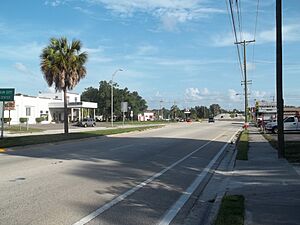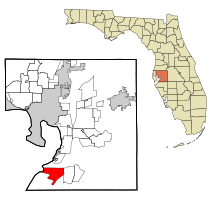Ruskin, Florida facts for kids
Quick facts for kids
Ruskin, Florida
|
|
|---|---|
 |
|

Location in Hillsborough County and the state of Florida
|
|
| Country | United States |
| State | Florida |
| County | Hillsborough |
| Established | August 7, 1908 |
| Named for | John Ruskin |
| Area | |
| • Total | 19.53 sq mi (50.59 km2) |
| • Land | 18.19 sq mi (47.11 km2) |
| • Water | 1.34 sq mi (3.48 km2) |
| Elevation | 3 ft (1 m) |
| Population
(2020)
|
|
| • Total | 28,620 |
| • Density | 1,573.31/sq mi (607.46/km2) |
| Time zone | UTC-5 (Eastern (EST)) |
| • Summer (DST) | UTC-4 (EDT) |
| ZIP Codes |
33570-33573, 33575
|
| Area code(s) | 813 |
| FIPS code | 12-62275 |
| GNIS feature ID | 0290065 |
Ruskin is a community located in Hillsborough County, Florida, in the United States. It's not a city with its own government, but a "census-designated place," which means it's a special area defined for counting people. Ruskin was founded on August 7, 1908, by the Little Manatee River. It was started by Dr. George McAnelly Miller and his wife, Addie Dickman Miller. They named the community after John Ruskin, a famous English writer and thinker. The Millers also started a college here called Ruskin College.
Contents
History of Ruskin
How Did Ruskin Get Its Name?
The town of Ruskin and its college were named after John Ruskin, an English writer and social reformer. He believed in the importance of good work and education for everyone.
When Was Ruskin Founded?
In 1907, Dr. George McAnelly Miller, a former professor, moved to the area with his family. They bought land and began building homes, a sawmill, and a school. Dr. Miller's wife, Addie Dickman Miller, opened a post office on August 7, 1908. This date is considered the official founding day of Ruskin.
In 1910, the Ruskin Commongood Society planned out the town. They set aside areas for the college, businesses, parks, and homes for the founding families.
Ruskin College and Early Life
The Millers opened a new Ruskin College in 1910. Students at the college worked part of each day. This helped them pay for their education and learn practical skills. The college taught subjects like art, music, and social sciences. At its busiest, the college had 160 students.
By 1913, Ruskin had a general store, a canning factory, and even its own telephone and electricity systems. A weekly newspaper was also published. Boats regularly traveled to Tampa, carrying goods and people.
Ruskin During World War I and After
When World War I began, many students left the college to join the war. Because of this, the college closed. In 1918, a fire destroyed the college buildings, but the Millers' house was saved. Dr. Miller passed away in 1919.
Around this time, roads like U.S. Route 41 were built to help farmers transport their crops. A railroad track also connected Ruskin to a main line in 1913. By 1918, about 200 people lived in Ruskin, many of whom were farmers. They had local businesses like a sawmill and general stores. Even after the college was destroyed, the community continued to thrive.
Ruskin in the 1920s and 1930s
By 1925, Ruskin still had about 200 people but had grown. It had hotels, sawmills, a public library, and several stores. Farmers grew tomatoes, cabbages, and onions. The community also had social clubs and a new school and church. Roads improved, making it easier to travel to nearby towns like Tampa.
By 1930, Ruskin's population grew to 709 people. Even during the Great Depression, Ruskin's strong farming community helped it survive. The soil in Ruskin is great for growing tomatoes because of a special layer of marl underneath. This helps keep fertilizer in the soil, even with irrigation from the many artesian wells.
Farmers worked together, and Ruskin became a busy community again. It had a canning plant that employed 65 workers. In 1935, the community started the annual Ruskin Tomato Festival to celebrate its farming success. This festival still happens every May!
Ruskin's Growth After World War II
During World War II, many Ruskin residents worked in Tampa. People from Tampa learned about the benefits of living in Ruskin. After the war, more people who were not farmers started moving to the community, making it more suburban.
In the 1960s and 1970s, farming was still very important in Ruskin. By 1975, the population reached 17,000, with many new residents not being farmers. By 1982, Ruskin produced a lot of tomatoes, and one of the world's largest tomato-packing houses was nearby. Other businesses like flower farms, real estate, and tropical fish farms also became important.
Changes in Farming and Modern Ruskin
In the late 1980s, some farmers faced difficulties due to poor crop yields. Many had to borrow money, and some were forced to stop farming. In the 1990s, new trade agreements allowed more tomatoes from Mexico to enter the U.S. market, which also affected local tomato farming. As a result, less land was used for growing tomatoes.
In the early 2000s, a housing boom turned many tomato and orange farms into new housing developments. This brought thousands of new people to Ruskin.
Today, Ruskin continues to grow with new businesses and homes. U.S. Route 41 and Interstate 75 connect Ruskin to Tampa and other cities. Ruskin is also home to the South Hillsborough County Government Center and a branch of the public library. In 2009, a new campus for Hillsborough Community College was built in Ruskin.
Geography of Ruskin
Where is Ruskin Located?
Ruskin is in the southern part of Hillsborough County, Florida. It is located north of the Little Manatee River. To its north is Apollo Beach, and to its east is Sun City Center.
How Big is Ruskin?
U.S. Route 41 goes through the middle of Ruskin. This road leads north to Gibsonton and southwest to Bradenton. Interstate 75 runs along the eastern side of Ruskin. It connects Ruskin to Brandon to the north and Sarasota to the south. Downtown Tampa is about 24 miles north.
According to the United States Census Bureau, the Ruskin area covers about 19.5 square miles (50.6 square kilometers). Most of this area is land, with a smaller part being water.
Population and People
| Historical population | |||
|---|---|---|---|
| Census | Pop. | %± | |
| 1960 | 1,894 | — | |
| 1970 | 2,414 | 27.5% | |
| 1980 | 5,117 | 112.0% | |
| 1990 | 6,046 | 18.2% | |
| 2000 | 8,321 | 37.6% | |
| 2010 | 17,208 | 106.8% | |
| 2020 | 28,620 | 66.3% | |
| source: | |||
Who Lives in Ruskin?
In 2010, there were 17,208 people living in Ruskin. The community is made up of people from many different backgrounds. About 71.7% were White, and 9.1% were Black or African American. About 42.9% of the population identified as Hispanic or Latino.
There were nearly 3,000 households in Ruskin. About 29.8% of these households had children under 18. The average household had about 2.79 people.
The population is spread out by age. About 26.5% of residents were under 18, and 16.1% were 65 or older. The average age in Ruskin was 35 years old.
The Redlands Christian Migrant Association (RCMA) helps families, especially those of migrant farm workers. They offer childcare, community support, and adult education programs.
Economy and Jobs
What Kinds of Businesses are in Ruskin?
In 2013, Governor Rick Scott and Amazon announced that Amazon would create 3,000 new jobs in Florida. A large Amazon warehouse was built in Ruskin. It's over one million square feet, which is about ten times the size of an average Home Depot store. The first item shipped from this warehouse was an Anna doll from the movie Frozen on September 18, 2014. Amazon also uses special robots called Kiva robots in its Ruskin facility. In 2016, Amazon added a training center at the site where employees can take college courses.
Arts and Culture
What is The Big Draw?
The annual BIG DRAW-Ruskin started in 2008. It celebrated Ruskin's 100th anniversary and honored John Ruskin's ideas about art and education. The event is part of an international effort to promote drawing as a way to learn and understand.
In 2008, artist Michael Parker and a community team created the Ruskin Community Mural. Teenagers and adults from Ruskin worked together on the mural. It shows John Ruskin's idea that happiness comes from using your head (thinking), heart (feeling), and hand (creating). The mural includes images of Ruskin's history, farming, and hopes for the future.
In 2009, another mural was painted on the Mary & Martha House building. Both mural projects were supported by local arts groups and grants.
Places to Visit
Ruskin has several interesting places to visit, some of which are listed on the National Register of Historic Places.
- A. P. Dickman House: One of the oldest homes in Ruskin.
- Cockroach Bay Aquatic Preserve: A protected area for water plants and animals.
- Cockroach Key: A small island.
- Firehouse Cultural Center: A place for arts and culture.
- Fountain of Youth: A local landmark.
- Little Manatee River State Park: A state park along the river.
- Trooper Kenneth E. Flynt Hwy.: A section of Highway 41 named after a fallen trooper.
- Leisey Shell Pits: A famous site near the Little Manatee River. It's one of the world's largest collections of Ice Age animal fossils.
- George McA. Miller House: The home of one of Ruskin's founders.
Education in Ruskin
What Schools are in Ruskin?
In 2014, the J. Vince Thompson Elementary School opened in Ruskin. It's the first school in Hillsborough County to be certified as a LEED building. This means it was built using environmentally friendly methods. The school is next to Lennard High School and the Hillsborough Community College SouthShore campus.
The Hillsborough Community College SouthShore campus is also in Ruskin. It has a LEED Gold certification, showing its commitment to green building. This campus includes the Lennard Collegiate Academy.
In 2014, Gannon University, based in Pennsylvania, announced it would open a new campus in Ruskin. This campus offers graduate programs in health professions. It was chosen to help meet the growing need for healthcare workers in Florida.
Media and News
Local Radio and Newspaper
Ruskin has its own community radio station, WPHX 101.9 FM, called The Phoenix. It started broadcasting on August 17, 2015, from the Firehouse Cultural Center.
The Observer News is a weekly newspaper that covers news in Ruskin and the surrounding South Hillsborough County area. It has been a local source of information for many years, starting in 1958.
Famous People from Ruskin
- Aaron Carter, singer
- Leslie Carter, singer
- Nick Carter, musician, from the Backstreet Boys
- Willa Ford, singer and actress
- Kathleen de la Peña McCook, library science professor
- Addie Dickman Miller, co-founder of Ruskin College
- Diontae Johnson, American Football wide receiver
See also
 In Spanish: Ruskin (Florida) para niños
In Spanish: Ruskin (Florida) para niños


